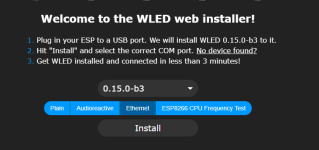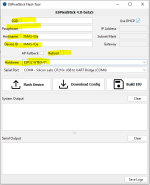I have a WT32 ETH01 with Wled firmware. I am trying to get it to work with Vixen. I would like to use it as a e1.31 controller. I am so confused now that I don't know what I have done and not done. I was hoping that someone could point me in the right direction. This is my first time of building a controller. I was hoping to put espixelstick firmware on it, but I can't get it to load. Any suggestions would be greatly appreciated.
You are using an out of date browser. It may not display this or other websites correctly.
You should upgrade or use an alternative browser.
You should upgrade or use an alternative browser.
Will Vixen work with Wled
- Thread starter AJVenti
- Start date
MartinMueller2003
Supporting Member
What is the issue? Can you post the log from the flashtool. Using the WT32 board is not as straightforward as using a node MCU based board. It will require you to manually reboot the WT32 multiple times with GPIO0 (zero) pulled low and then one last time with GPIO0 floating.I have a WT32 ETH01 with Wled firmware. I am trying to get it to work with Vixen. I would like to use it as a e1.31 controller. I am so confused now that I don't know what I have done and not done. I was hoping that someone could point me in the right direction. This is my first time of building a controller. I was hoping to put espixelstick firmware on it, but I can't get it to load. Any suggestions would be greatly appreciated.
The other issue we see is a permissions issue when trying to run Flashtool on a MAC. Forkineye has a set of workarounds for that.
I got wled to load after trying all-day yesterday. What I can't do is get it to work with vixen. I was thinking that I would flash espixelstick firmware on to it but can't get it to work. I have a couple espixelsticks that I have used so I am familiar with it. Should I try to put the espixelstick firmware on it or will the wled firmware work just as well.
MartinMueller2003
Supporting Member
WLEd needs to be set up as E1.31. Create an E1.31 controller in vixen. Patch needed output channels to the controller. Create a test sequence and play it.
MartinMueller2003
Supporting Member
You will need to tell wled what the starting universe is. I would start with unicast and universe 0. You can get fancy once it is working.
I actually just had issues with flashing the WT32 ETH01 boards and here is what I figured out.
For WLED flash the device using the web-based flash tool, it's just easy this way. Be sure to choose the Ethernet Option.
https://install.wled.me/

OR
You can use the ESPixel Stick firmware, use the latest 4.0 beta 5 https://github.com/forkineye/ESPixelStick/releases.
The flash tool doesn't really work as it clears the EEPROM then tries to reboot the device, this always fails, so I use the following from command prompt to manually erase and then flash the firmware.

First run the flash tool and let it fail, be sure to fill out your options and choose your hardware ESP32 ETH01, Uncheck Reboot on AP failure.
This will build the firmware to manually flash.
Then run these from the folder you extract from the Pixel stick firmware. (Change your COM port and speeds to match your setup)
Unplug and replug in your USB flashing device so it resets then run
If you do use the ESPixel stick firmware and are going to be using wired ethernet only, be sure the "Reboot on AP failure" options are unchecked, else you'll end up in a boot loop.
This should get you running with either WLED or ESPixel Stick v4 on your WT32 ETH01 device. I've got both firmware up and running on my controllers now.
For WLED flash the device using the web-based flash tool, it's just easy this way. Be sure to choose the Ethernet Option.
https://install.wled.me/

OR
You can use the ESPixel Stick firmware, use the latest 4.0 beta 5 https://github.com/forkineye/ESPixelStick/releases.
The flash tool doesn't really work as it clears the EEPROM then tries to reboot the device, this always fails, so I use the following from command prompt to manually erase and then flash the firmware.

First run the flash tool and let it fail, be sure to fill out your options and choose your hardware ESP32 ETH01, Uncheck Reboot on AP failure.
This will build the firmware to manually flash.
Then run these from the folder you extract from the Pixel stick firmware. (Change your COM port and speeds to match your setup)
Code:
bin\win32\python3\python bin\upload.py --chip esp32 --baud 115200 --port COM4 erase_flashUnplug and replug in your USB flashing device so it resets then run
Code:
bin\win32\python3\python bin\upload.py --chip esp32 --baud 115200 --port COM4 --before default_reset --after hard_reset write_flash -z 0x1000 firmware\esp32\esp32_wt32eth01-bootloader.bin 0x8000 firmware\esp32\esp32_wt32eth01-partitions.bin 0xe000 firmware\esp32\boot_app0.bin 0x10000 firmware\esp32\esp32_wt32eth01-app.bin 0x3B0000 firmware\filesystem.binIf you do use the ESPixel stick firmware and are going to be using wired ethernet only, be sure the "Reboot on AP failure" options are unchecked, else you'll end up in a boot loop.
This should get you running with either WLED or ESPixel Stick v4 on your WT32 ETH01 device. I've got both firmware up and running on my controllers now.
MartinMueller2003
Supporting Member
i suggest using the latest ci build. beta 4 has had many bug fixes.
Well, I have been playing with the Wled firmware with Vixen, I got a Wasatch Duo with Two outputs. I put 105 pixels on one output and 105 on the other the #1 output will work on all 105 pixels but the #2 output I don't get the first 60pixels to work, the ones after the 60 work. I am sure that there a setting I am missing.
Thanks
Tony
Thanks
Tony
Attachments
Assuming a 512 universe size, the Vixen setup should be 512 instead of 315 on the first universe and then the 2nd one would be 118 instead of 315. If you are using 510 universe size you would just adjust it to 510 and 120.
This skip is because the controller is starting at a specific universe and using all the channels in sequence. You are skipping a block in the Vixen setup by skipping the remainder of universe 1.
This skip is because the controller is starting at a specific universe and using all the channels in sequence. You are skipping a block in the Vixen setup by skipping the remainder of universe 1.




